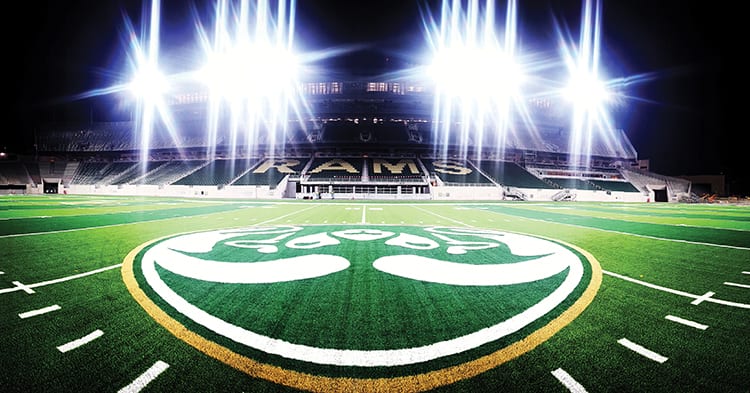Colorado State Stadium: Rams Charge Back to Campus

WORDS: Eric Peterson
After 48 years, Colorado State University’s football team is coming home. The Rams played for the last time at off-campus Hughes Stadium in late 2016, after 262 games, not to mention a few gigs by the Rolling Stones, Bob Dylan and other rock legends.
It can be hard to turn the page, but the shiny, new Colorado State Stadium is undeniably slick. The $220 million, 41,000-seat venue came in on schedule easily in time for the first kickoff Aug. 26.
Bringing the stadium back to campus isn’t about football alone, says CSU Athletic Director Joe Parker.
“Playing football on campus provides the largest engagement opportunity for the university six times each year,” he says. “Alumni who come to football games will be back on campus, walking in the same places they walked as students and showing their families this beautiful campus. Something that is very exciting is to see people experience the stadium for the first time in person, and to see that something very special has been built here.”
Like football, the project was ultimately based on teamwork.
“We have had a really strong team in place from the start with our design partner Populous, our construction partner Mortenson and our owner’s representation with ICON Venue Group, and then all the internal resources on campus,” says Parker. “We did a lot of planning and kept a lot of strong communication throughout the process of construction, so it has been, in my estimation, a nearly flawless execution of a very complex plan.”
Gene Hodge, vice president of project development for Mortenson’s Denver Operating Group, seconds that notion.
“I think everybody works pretty well together,” Hodge says of the team, noting that Populous and Mortenson have collaborated on a number of sports venues. “We spent a lot of time as a team looking at what options were available.
“For a $220 million project, a 20-month schedule is super fast,” Hodge says of the challenges. “It’s a combination of cast-in-place, precast and steel, so it’s a challenge to schedule.”
But the schedule was maintained throughout construction, and part of it was the team’s vast experience building sporting venues, he adds. ICON and Populous are both focused on stadiums and arenas for professional and college teams, and Mortenson has built more stadiums than any other contractor, including such marquee projects as the Minnesota Vikings new U.S. Bank Stadium in Minneapolis and the Golden State Warriors under-construction Chase Center in San Francisco.
But Colorado State Stadium was a special one for Mortenson, says Hodge.
“We’re extremely active with CSU. I think we have 75 or 80 alumni” – including the project engineer, Cameron Moss, a former tight end for the Rams.
Beyond the alumni connection, the multipurpose vision distinguishes the project, he adds.
“They looked at it as not just a football stadium, but a catalyst for the growth and development of the university, which was a pretty interesting take,” Moss says. “They’re looking to use it 365 days a year.”
Myron Chase, the project’s architect with Populous, says the trickiest task might have been balancing football uses with other university functions.
“You’re designing a stadium for 40,000 people, but you’re also designing it for day-to-day use,” says Chase, citing the 80,000-square-foot Alumni and Academic Center on the east side. “It’s not just a seven- or eight-day-a-year venue.”
Chase has worked on stadiums his entire career, including University of Minnesota TCF Bank Stadium and University of Phoenix Stadium, home of the Arizona Cardinals. After completing a master plan for Colorado State Stadium in 2012, Chase and this team started working on the stadium design in 2013.
He says the goal was “making this fit in with the rest of campus,” taking cues from “vernacular and vocabulary” of the prevailing mid-century modern architecture and using similar building materials. “Colorado sandstone is prominent on campus so we used a lot of it,” he says. “We really looked at the campus buildings.” He highlights another notable feature in a craft-beer bar, the New Belgium Porch on the north end of the stadium. “The hope is to have it open on nongame days,” says Chase. “The weather’s beautiful, they have mountain views, there are great beers.”
 Chase labels it as one of the smoothest projects of his career.
Chase labels it as one of the smoothest projects of his career.
“There are always budget challenges, but with the collaborative process working with CSU and ICON and Mortenson, and the back and forth, we were able to get them what they wanted,” he says.
CSU’s Parker agrees, and loves the finished product.
“We have, in many ways, built the best stadium in America, for this university, for our fans, for our football program, and for everybody who will enter and experience this facility on a year-round basis,” he says.
Featured in the September 2017 issue of Building Dialogue.













